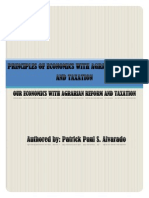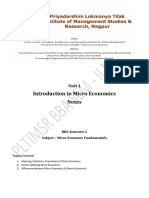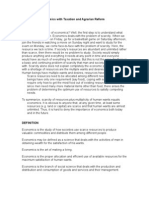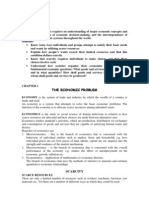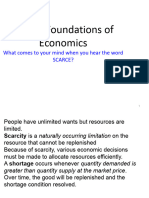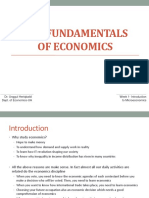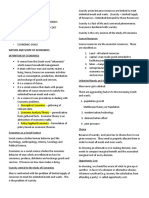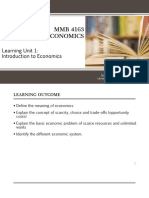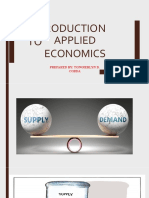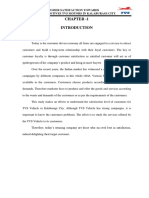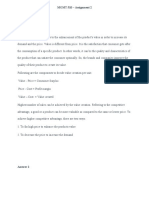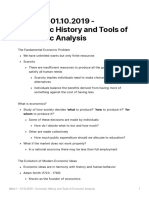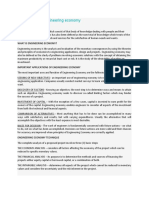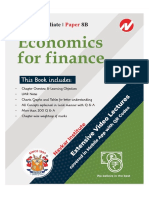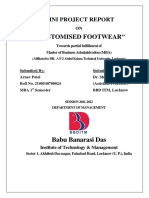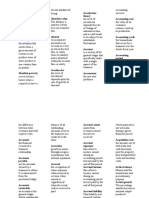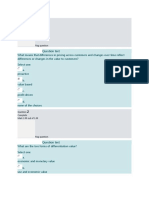5/17/2025
Introduction
Basic Concepts of Economics
The basic economic problem
• Why does the basic economic problem arise?
• Human wants are unlimited or infinite
• people want better food, clothing, healthcare, recreation, things like mobile phone and so on.
• But, in a given time resources that we have to meet the wants are scarce,
• that is, resources are limited in supply.
• So, there is a conflict between unlimited wants and scarcity of resources
• We can not have everything we want with the limited resources.
• This conflict gives rise to the basic economic problem.
The economic problem will continue to exist in the future – scarcity continues to exist
because wants continue to grow and change over time
1
� 5/17/2025
The economic problem in different contexts
• Economic problem is faced by everyone.
• Consumers can not have everything they want (limited income)
• Students have to select which course to study ( limited time and income)
• Producers have to decide which goods to produce (inputs are scarce)
• Farmers have to decide whether to grow rice or wheat (land is scarce)
• The government has to decide how to spend tax income (tax revenue is scarce)
Scarcity and choice
• Most of the goods that we want are economic goods,
• They require resources for their production.
• Therefore, their production has a (opportunity) cost.
• Free goods do not need any resources to produce,
• Therefore, they do not have an opportunity cost.
• Very few goods are free. For example, Sunlight, air
• The resources available to satisfy our wants are, at any time, limited in supply.
Since most people can not have everything they want, they have to make a
choice.
• This is true for individuals as well as governments.
2
� 5/17/2025
Scarcity and Efficiency
• Given unlimited wants, it is important that an economy make the best use of its
limited resources.
• That brings us to the critical notion of efficiency.
• Efficiency denotes the most effective use of a society’s resources in satisfying
people’s wants and needs.
• Economic efficiency requires that an economy produce the highest combination
of quantity and quality of goods and services given its technology and scarce
resources.
Definition of Economics
• Economics is the study of how society manages its scarce resources to provide
for material well-being (i. e. to produce valuable goods and services).
• Economics is a social science because it is concerned with the behaviour of
people living in society (human behavior). That’s why economists’ job is much
more complex than natural scientists.
Consider a world without scarcity. If infinite quantities of every good could be
produced or if human desires were fully satisfied, what would be the consequences?
3
� 5/17/2025
Resources or factors of production or inputs
• Production consists of all those activities which provides goods and services to satisfy
wants.
• Production results in output such as consumer goods, producer goods or capital goods, and
services (intangible goods).
• But, production requires resources (also called inputs or factors of production). Four kinds
of factors of production.
• Land – Everything given by nature (natural resources)
• Labour – all human efforts both physical and mental
• Capital – Man-made resource - factory, machine etc.
• Entrepreneurship (enterprise) – which arranges production activity by combining land, labour
and capital, and take risks.
• Both quantity and quality of factors of production are important.
Two major branches of economics
• The Economics discipline has two major branches.
• Microeconomics: The study of how households and firms make choices, how they
interact in markets, and how the government attempts to influence their choices.
• Thus, microeconomics is the study of the small units of the economy.
• For example, the study of the market for cars. This involves looking at the decisions and
behavior of people who buy cars (consumers), and firms which sell cars (sellers), and
government which can influence the price of car by imposing tax on cars, for example.
• Macroeconomics: The study of the economy as a whole. It looks at topics such as
inflation or price level, unemployment rate, economic growth, foreign trade, and
government policy (fiscal or monetary).
• Macroeconomics is aggregated microeconomics. Therefore, the two branches are highly
related – one affecting the other.
4
� 5/17/2025
Questions facing all economies
• All societies face three fundamental questions (because of scarcity and unlimited
wants).
What goods and services shall be produced and in what quantities?
• This question is related to the composition of total output – food or weapon? Luxury goods or
necessities? Rice or Wheat?
• How much of the chosen goods will be produced?
• Society typically produces a combination of different goods. But, more of a good means less of
other(s). This is called a trade-off.
How should the goods and services be produced?
• Goods can be produced by a variety of production methods.
• Labour-intensive methods – use more labour compared to capital?
• Capital-intensive methods – more capital than labour?
• Society must decide which production method should be used.
For whom will the goods be produced?
• How should the produced goods be distributed/shared among the members of the community?
• Should everyone get an equal share? The poor should get more or the rich? 9
Economic systems to Answer the fundamental questions
• Command economy (or planned or socialist economy): A central authority or
government decides production and distribution (what to produce, how to produce,
and for whom to produce).
• The government owns most of the means of production (land and capital);
• it also owns and directs the operations of enterprises in most industries;
• it is the employer of most workers and tells them how to do their jobs; and
• it decides how the output of the society is to be divided among different goods and
services.
• In short, in a command economy, the government answers the major economic
questions through its ownership of resources and its power to enforce decisions.
• Example: The Soviet Union during most of the twentieth century, North Korea and
Cuba
10
5
� 5/17/2025
Economic systems to Answer the fundamental questions (cont.)
• Market economy: A market economy is one in which individuals and private firms make
the major decisions about production and consumption. Also called the free enterprise or
capitalist system.
• Private ownership, freedom of choice and enterprise, self-interest as dominating motive,
competition, are all characteristics of the system.
• Very limited role for government. The extreme case of a market economy, in which the
government keeps its hands off economic decisions, is called a laissez-faire economy.
• Closest Example. USA, Japan, UK (most of the production decisions are taken by the market)
• A system of prices, of markets, of profits and losses, of incentives and rewards
determines what, how, and for whom.
• Firms produce the commodities that yield the highest profits (the what )
• Firms use the techniques of production that are least costly (the how ).
• Consumption is determined by individuals’ decisions about how to spend the wages and
property incomes generated by their labor and property ownership (the for whom ). 11
Economic systems to Answer the fundamental questions (cont.)
• Mixed economy –Some decisions are taken by the market and some are taken by
the state/government
• No contemporary society falls completely into either of the polar categories
(command and market). Rather, all societies are mixed economies, with elements of
market and command.
• Ex. Bangladesh
• Today most decisions in the United States and other high-income economies
are made in the marketplace.
• But the government plays an important role in overseeing the functioning of
the market; governments pass laws that regulate economic life, produce
educational and police services, and control pollution.
Market
Command
12
6
� 5/17/2025
How does a market economy work?
• In a simple market economy, there are
• Households that are consuming units (buyers) and
• Firms that are producing units (sellers or producers)
• Households own the resources or factors of production (private ownership) and sell these resources to
the firms.
• The ownership of factors of production gives income to the households. Labor – wage, Land – rent,
Capital – Interest, Entrepreneur - Profit
• Firms use these resources to produce valuable goods or services, which are sold to households.
• Households use their income to buy these valuable goods
• Decision of what to produce: In a market economy firms or sellers will produce the goods
which consumers or buyers or households want to buy (has a demand for). Buyers signal
their preferences for goods through price mechanism. Producers will produce the goods
that ensure profit for them.
• Decision of how to produce: Firms will choose the lowest cost production technique so
that they can maximize their profit.
• Decision of whom to produce: Household that owns more resources, will have higher
income, and therefore, will command more goods produced.
13
Price mechanism
• In a market economy, the price mechanism allocates resources to various uses. Here
• the decision of buyers determines demand of a product/commodity/services
• The decision of producers/sellers determine the supply of a product/services
• The interaction of demand and supply determines product/service’s price which is used for exchange of
the goods/services.
• Resources move (are allocated) automatically to different prodution as a result of changes
in price.
• Price change occurs due to the interactions of market forces – demand and supply.
• Example 1: Apple becomes very popular among the consumers
• There will be an increase in demand for apple
• The price of apple will go up
• Producers will be producing more apple since it’s more profitable to do so
• More labour, capital and land will be used for apple production. That is, resources will be moved to apple
production from other sector (orange production, for example).
• Example 2: There is a demand for vaccination for a new contagious disease.
14
7
� 5/17/2025
Every point on the plane
represents the value of Y
corresponding to the value of
X. And, we denote it as (X, Y).
X, Y = (3, 2)
X, Y = (-2, 2)
Where X and Y axis
intersect that point is
called origin which has
values (X, Y) = (0, 0)
X, Y = (4, 0)
15
Machines
Food
16
8
� 5/17/2025
X Y
Point A Food, Machine = 0, 150)
10, 140
(50, 0)
17
0, 150)
10, 140)
20, 120)
18
9
� 5/17/2025
linear
Here, the relationship
between X and Y is
negative, or they are
inversely related or the
curve has a negative
slope.
If price of a product increases sales of
a firm will decrease
19
Linear)
Positive relationship, direct
relationship or positively sloped.
If income increases expenditure
also increases
If production increases cost
of production also increases
20
10
� 5/17/2025
Non-linear relationship
Inverted U shaped relationship,
The relationship between sales
and total revenue of a firm may
follow an inverted U-shaped
relationship.
Non-linear relationship
may be like U-shaped
21
Production possibility Curve (frontier)
• Production possibility curve (PPC) shows the various combinations of two goods which a
country can possibly produce by using all the available factors of production and the
available production technology.
• PPC represents society’s production capability.
• Production possibility of two goods - agricultural product and manufacturing product
Production Manufacturing Agricultural product
Possibility product (million (millions of tonnes)
tonnes)
A 0 60 Feasible, efficient
B 1 58 Feasible, efficient
C 2 55 Feasible, efficient
D 3 50
E 4 42
F 5 30
G 6 0 Feasible, efficient 22
11
� 5/17/2025
PPC in Graph
70
60 A B
C H
D
Agricultural Product
50
E
40 PPC
K F
30
20
10
0 G
0 1 2 3 4 5 6 7
Manufacturing Product
Production in any combinations that lies below the PPC is feasible but
inefficient. Production in any combinations above the PPC is not
feasible. 23
PPC continued
• PPC is downward sloping or has a negative slope, (if production of one product
increases, production of the other decreases) and concave to the origin (it is vowed
outward).
• Production on any point on the PPC is feasible and efficient because all available
resources and best available technology are used.
• Production on any point inside the PPC is feasible but are inefficient because
production in any point below PPC (such as point K) means some resources are not
being used up or best available technology is not used.
• Production on any point outside the PPC (such as H) is not feasible because available
resources and/or technology will not allow that.
24
12
� 5/17/2025
Shift in PPC
• If amount of resources increased (new resources discovery or quality of
existing resources enhanced) or technology is improved, PPC will shift
outward, and points such as H can be attainable (production potential
increases). This is known as economic growth.
25
Shift in PPC (cont.)
• PPC can shift inward, to the left, if a country’s production potential declines.
This could occur if existing resources are destroyed due to a war or natural
disasters.
26
13
� 5/17/2025
The concept of opportunity cost
• When economists talks about cost of something they talk about the opportunity cost.
Also called economic cost.
• The concept is very important to understand the behaviour of any economic agent (consumer or
producers or govt).
• The opportunity cost of a decision (or an activity) is the best alternative given up to
take the decision.
• what one must give up to obtain what he or she desires.
• What is the opportunity cost of buying a book for 100 taka?
• Giving up the opportunity of buying a music CD for 100 Taka.
• In most of the cases we can express opportunity cost in terms of price.
• But, when time in decision making is involved, then price may not be the same as the total
opportunity cost.
27
The opportunity cost versus accounting cost
• What is the cost of buying a book for 100 taka?
• Accountant = 100 Taka
• Economist cost is the next best thing that you could buy/do with that 100 taka (buying a CD, or Sharma)
• Price is the same as opportunity cost
• No difference between accounting cost and economic cost.
• What is the cost of watching a movie in the cinema hall?
• Accounting cost = Cost of ticket, transportation (explicit cost)
• Economist (Opportunity cost = Explicit cost + Cost of the time you have spend for watching the movie (implicit
cost).
• What is the opportunity cost of being a full-time Masters student?
• Accounting cost = cost of tuition, books, etc. (explicit cost)
• Economic cost = Explicit + opportunity cost of your time (you could do a job instead of doing master degree)
• You are currently working in a RMG firm. What is the opportunity cost of starting up your own
business?
• What is the opportunity cost of using a piece of land for wheat production?
• What is the opportunity cost of spending money by the government for healthcare?
28
14
� 5/17/2025
PPC and Opportunity Cost
• The Concept of opportunity cost can be explained by the PPC.
• If we move along the PPC we increase the production of one commodity but have to
decrease (give up) the production of the other commodity.
• The production of more and more manufacturing products means less and less of agricultural products.
• The opportunity cost of producing 1 million tonne of manufacturing products (from A to B)
is giving up the production of 2 million tonnes of manufacturing product.
Production Manufacturing product Agricultural product Opportunity cost of
Possibility (million tonnes) (millions of tonnes) producing manuf
A 0 60 -
B 1 58 2
C 2 55 3
D 3 50 5
E 4 42 8
F 5 30 12
G 6 0 30 29
PPC and Opportunity Cost
Production Manufacturing product Agricultural product Opportunity cost
Possibility (million tonnes) (millions of tonnes)
A 0 60 -
B 1 58 2
C 2 55 3
D 3 50 5
E 4 42 8
F 5 30 12
G 6 0 30
• From point B to C, production of one more million tons of manufacturing product means
decrease in production of agricultural product by 3 tonnes.
• The opportunity is increasing (last column). Because of the increasing opportunity cost, PPC is concave.
30
15
� 5/17/2025
PPC and Opportunity Cost
• Why might opportunity cost be increasing? (Why is PPC concave?)
• Not all resources are equally good at producing both manufacturing and agricultural
products.
• Some resources are more efficient at producing manufacturing products
• Some resources are more efficient at producing agricultural products
• Initially, when manufacturing production is increased, resources that are less efficient
in agriculture (and more efficient in manufacturing) will be released. So, one unit
increase in manufacturing production can be done by releasing a small amount of
(efficient) resources (opportunity cost will be smaller).
• Eventually, as manufacturing production increases, less efficient resources in
manufacturing have to be released (opportunity cost will be larger and larger).
31
Positive versus Normative statements/economics
• Positive versus Normative statements/economics
• Positive statement are those that deal with only facts, how things are. If disagreement
about the statements arise, they can be tested by looking at the facts/data
• Growth rate of Bangladesh was 5.2% this year, or
• imposition of tax on Cigarette increases the price of Cigarette.
• Normative statements are about what “ought to” or “should” be. These statements are
based on value judgements. Disagreement about these statements are settled by
voting on them or through a political process.
• Government should spend more on education or
• Cigarette should be heavily taxed.
32
16




